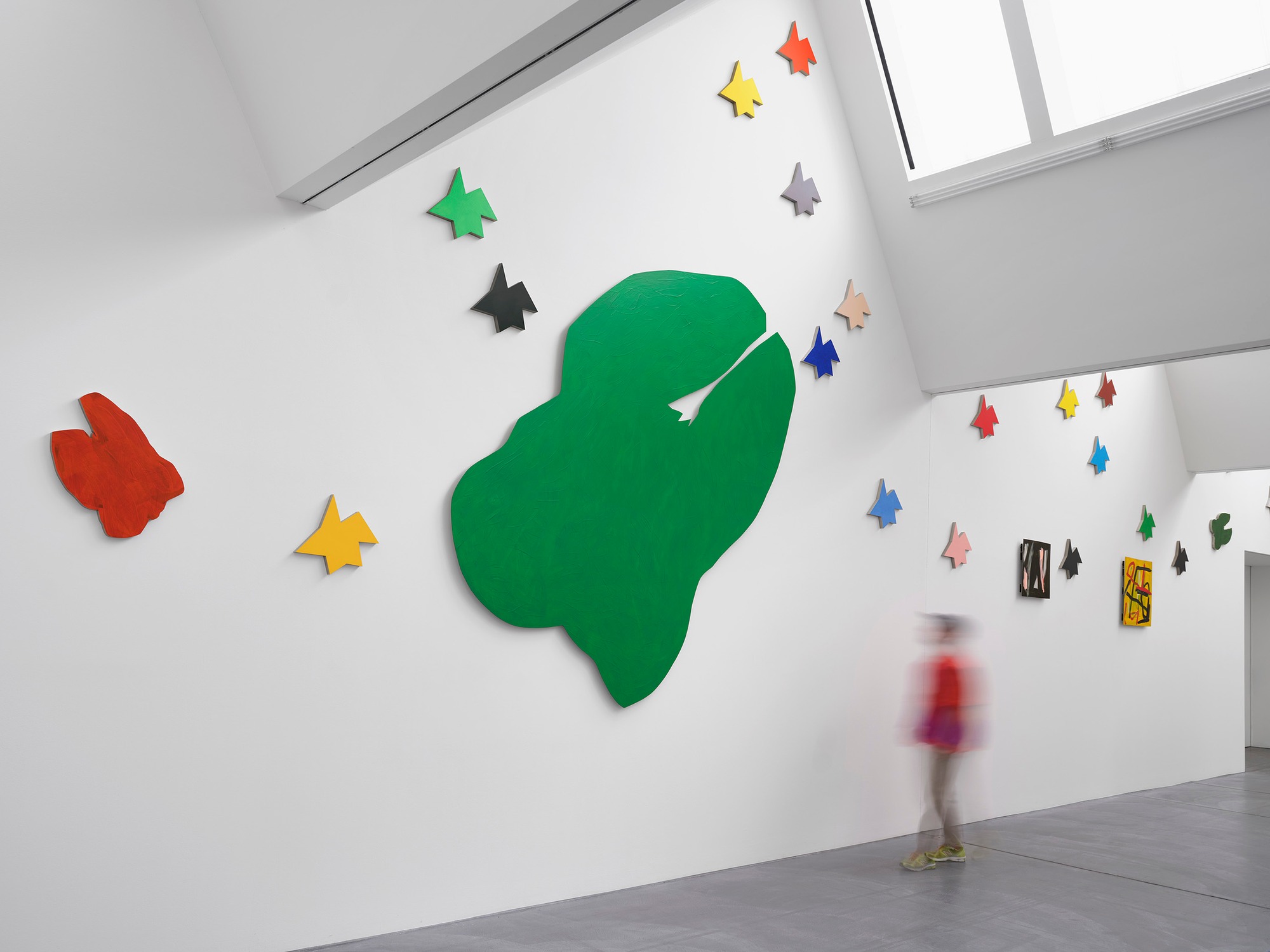What Is Essential Is Invisible to the Eye

In a stellar exhibition, Düsseldorf-based artist Imi Knoebel urges us to look closely, not only with our eyes but with our hearts.
by
Claudio Vogt - von Bartha Team
With his current exhibition, In den Sternen …, at von Bartha in Basel, Imi Knoebel forces us to turn our gaze upwards, literally, by hanging his works high up under the gallery roof and, symbolically, by letting us stare into a firmament. Spread across the outer walls of the entire exhibition space, dozens of star-shaped works from the Kinderstern series (1988–2024) are centered around works from other series. Although the aluminum stars are all the same in shape, each of these 122 artworks has its nuanced character. Some are radiant, shimmering, even garish, while others are soft, somber, and rather cool. The hand-applied color is never the same for any two stars from the entire group of works.

Imi Knoebel
works form the "Kinderstern" series, 1989/2023
Photo: Philipp Hänger

Imi Knoebel, "In den Sternen ..."
Exhibition view
von Bartha, Basel
Photo: Philipp Hänger

Imi Knoebel
works form the "Kinderstern" series, 1989/2023
Photo: Philipp Hänger

Imi Knoebel, "In den Sternen ..."
Exhibition view
von Bartha, Basel
Photo: Philipp Hänger

Imi Knoebel
view on "Kleiner Archetyp 6a," 2021, and "Kinderstern," 1989/2023
Photo: Philipp Hänger

Imi Knoebel
view on "Etcetera LXI," 2023, and works form the "Kinderstern" series, 1989/2023
Photo: Philipp Hänger
In addition to form and color, the Kinderstern series bears a deeper meaning. Knoebel invites us to turn our gaze inwards as well. From a distance, we humans (like stars) all appear to be the same. But at our core, we are very unlike each other, especially when it comes to the preconditions and opportunities we were given at birth. Knoebel has therefore developed the Kinderstern series with a clear purpose in mind: Three-quarters of the proceeds from the stars exhibited go to the charitable organization Kinderstern e.V. and thus benefit children in need, the most precarious among us. Kinderstern serves as both a call to action and a celebration of childhood, a shared experience that connects us all, no matter our future accomplishments. “All grown-ups were once children… but only few of them remember it,” says the Little Prince in the book of the same name – who himself lives on an asteroid – and he adds “It is only with the heart that one can see rightly; what is essential is invisible to the eye.”
Also challenging to grasp are the temporal dimensions of the Archetyp series (2022–2024). The origin of these works ultimately lies in the mammoth ivory sculpture known today as the Venus of Hohlefels, created around 35-40,000 years ago. This six-centimeter-high figure is one of the world’s oldest depictions of the human body. Since its discovery, both plausible and less convincing interpretations have followed one another, particularly documenting man’s fascination with itself and its egocentricity. Knoebel’s Venus, which he calls Archetyp, and which exists in various sizes and colors, is only remotely reminiscent of the silhouette of the ivory sculpture. Knoebel’s model is more reduced and simplified, consisting solely of form and color on aluminum. Yet, we viewers cannot help but want to recognize something in these works: a molar, a roast chicken, or a lobster claw. This innate curiosity and the urge to understand and interpret the world around us is not only the origin of culture and art; it ultimately makes us human. With this group of works, Knoebel reminds us of that once again.

Imi Knoebel
Etcetera CLXXIII, 2024
Acrylic on aluminum
198.7 x 183.5 x 4.5 cm

Imi Knoebel
Etcetera CLX, 2024
Acrylic on aluminum
144 x 131.3 x 4.5 cm

Imi Knoebel
Etcetera CLXI, 2024
Acrylic on aluminum
161.2 x 147 x 4.5 cm

Imi Knoebel
Etcetera CXXXIII, 2024
Acrylic on aluminum
78.2 x 62.4 x 4.5 cm
The latest series in Knoebel’s oeuvre, and the first that visitors encounter in the exhibition, is Etcetera (2023–2024). In contrast to the planarity and reduction to the essential (as in Kinderstern) or the archaic (as in Archetyp), Knoebel opens up deep visual spaces here. With each application of paint on the seemingly rectangular formats, a new layer is created without completely covering up the previous composition. Here, too, Knoebel draws on the entire spectrum of his color palette. Some of the paintings change color as we pass by: a rich pink suddenly becomes a glossy gray-green.
The vaguely recognizable motifs are reminiscent of well-known works from his oeuvre: for example, the grid structure of older Cut-up works is dimly noticeable, outlines of Big Girl works emerge from the background alongside fields of color as in the Anima Mundi series, briskly painted, tumbling, the brushstroke sometimes reaching beyond the edge. Are we seeing the artist’s retrospective view of his own work here? It is said that silhouettes dissolve in memory, proportions shift, and colors mix. However, the Latin expression et cetera (as well as the ellipsis in the exhibition title) suggests that it is less a retrospective and more a phrasing of further, unspoken things, a look into the future perhaps, and an open end.
The exhibition In den Sternen … at von Bartha in Basel runs from November 8, 2024, to February 22, 2025. You can find more information about the German artist Imi Knoebel (b. 1940) here.

